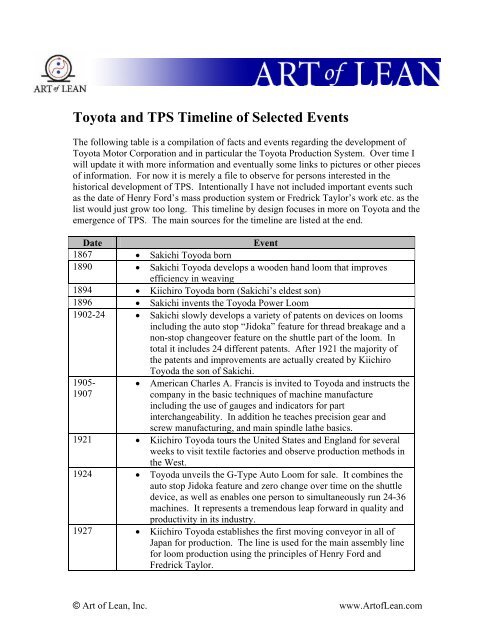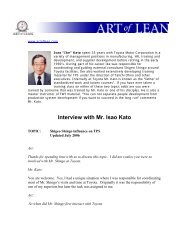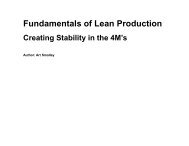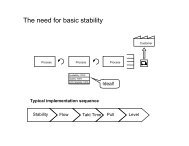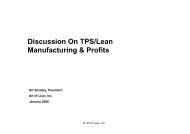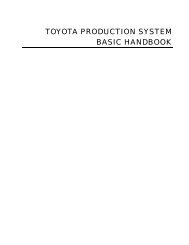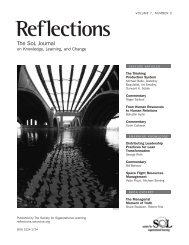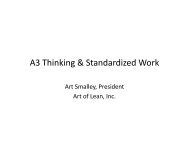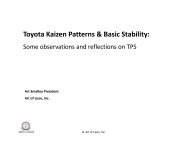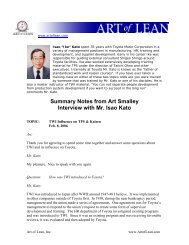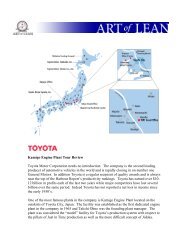Toyota and TPS Timeline of Selected Events - Art of Lean
Toyota and TPS Timeline of Selected Events - Art of Lean
Toyota and TPS Timeline of Selected Events - Art of Lean
You also want an ePaper? Increase the reach of your titles
YUMPU automatically turns print PDFs into web optimized ePapers that Google loves.
<strong>Toyota</strong> <strong>and</strong> <strong>TPS</strong> <strong>Timeline</strong> <strong>of</strong> <strong>Selected</strong> <strong>Events</strong><br />
The following table is a compilation <strong>of</strong> facts <strong>and</strong> events regarding the development <strong>of</strong><br />
<strong>Toyota</strong> Motor Corporation <strong>and</strong> in particular the <strong>Toyota</strong> Production System. Over time I<br />
will update it with more information <strong>and</strong> eventually some links to pictures or other pieces<br />
<strong>of</strong> information. For now it is merely a file to observe for persons interested in the<br />
historical development <strong>of</strong> <strong>TPS</strong>. Intentionally I have not included important events such<br />
as the date <strong>of</strong> Henry Ford’s mass production system or Fredrick Taylor’s work etc. as the<br />
list would just grow too long. This timeline by design focuses in more on <strong>Toyota</strong> <strong>and</strong> the<br />
emergence <strong>of</strong> <strong>TPS</strong>. The main sources for the timeline are listed at the end.<br />
Date<br />
Event<br />
1867 • Sakichi Toyoda born<br />
1890 • Sakichi Toyoda develops a wooden h<strong>and</strong> loom that improves<br />
efficiency in weaving<br />
1894 • Kiichiro Toyoda born (Sakichi’s eldest son)<br />
1896 • Sakichi invents the Toyoda Power Loom<br />
1902-24 • Sakichi slowly develops a variety <strong>of</strong> patents on devices on looms<br />
including the auto stop “Jidoka” feature for thread breakage <strong>and</strong> a<br />
non-stop changeover feature on the shuttle part <strong>of</strong> the loom. In<br />
total it includes 24 different patents. After 1921 the majority <strong>of</strong><br />
the patents <strong>and</strong> improvements are actually created by Kiichiro<br />
Toyoda the son <strong>of</strong> Sakichi.<br />
1905-<br />
1907<br />
• American Charles A. Francis is invited to Toyoda <strong>and</strong> instructs the<br />
company in the basic techniques <strong>of</strong> machine manufacture<br />
including the use <strong>of</strong> gauges <strong>and</strong> indicators for part<br />
interchangeability. In addition he teaches precision gear <strong>and</strong><br />
screw manufacturing, <strong>and</strong> main spindle lathe basics.<br />
1921 • Kiichiro Toyoda tours the United States <strong>and</strong> Engl<strong>and</strong> for several<br />
weeks to visit textile factories <strong>and</strong> observe production methods in<br />
the West.<br />
1924 • Toyoda unveils the G-Type Auto Loom for sale. It combines the<br />
auto stop Jidoka feature <strong>and</strong> zero change over time on the shuttle<br />
device, as well as enables one person to simultaneously run 24-36<br />
machines. It represents a tremendous leap forward in quality <strong>and</strong><br />
productivity in its industry.<br />
1927 • Kiichiro Toyoda establishes the first moving conveyor in all <strong>of</strong><br />
Japan for production. The line is used for the main assembly line<br />
for loom production using the principles <strong>of</strong> Henry Ford <strong>and</strong><br />
Fredrick Taylor.<br />
© <strong>Art</strong> <strong>of</strong> <strong>Lean</strong>, Inc. www.<strong>Art</strong><strong>of</strong><strong>Lean</strong>.com
1929 • Kiichiro Toyoda again visits the U.S. <strong>and</strong> tours American textile<br />
<strong>and</strong> loom manufacturing companies such as Draper & Compton,<br />
<strong>and</strong> Knowles among others. He further observes the emerging<br />
U.S. auto industry.<br />
• Sale <strong>of</strong> the patent rights to the G-Type Auto Loom to Platt<br />
Brothers in Engl<strong>and</strong> is initially negotiated for the sum <strong>of</strong> £100,000<br />
pounds. This amount provides some seed money for the<br />
experiments leading to engine development <strong>and</strong> the automotive<br />
department within Toyoda Auto Loom<br />
1930 • Kiichiro Toyoda returns to Japan from Britain <strong>and</strong> begins initial<br />
study <strong>and</strong> development <strong>of</strong> gasoline internal combustion engines.<br />
1931-32 • Kiichiro Toyoda initiates the collection <strong>of</strong> precision machine tools<br />
from Germany <strong>and</strong> the U.S. that will be necessary to support<br />
automotive production.<br />
• Initial development work <strong>and</strong> a formal prototype engine is<br />
produced in 1933. The engine is based <strong>of</strong>f a Chevrolet design.<br />
1933 • An automobile department formally established within the Toyoda<br />
Auto Loom Company.<br />
1936 • The first prototype vehicles are completed by Toyoda in 1936.<br />
1937 • <strong>Toyota</strong> Motor Corporation is <strong>of</strong>ficially established. Kiichiro<br />
Toyoda is President.<br />
• Eiji Toyoda (Kiichiro’s cousin) joins the company after graduation<br />
from Tokyo University’s mechanical engineering department.<br />
• A new factory is built in Koromo, Japan (present day <strong>Toyota</strong> City)<br />
about 30 minutes outside <strong>of</strong> Nagoya.<br />
• A 10 centimeter thick document authored by Kiichiro is used to<br />
layout the factory, the process flow, <strong>and</strong> provides a basis for<br />
training the workers in the new flow style <strong>of</strong> production. Eiji later<br />
calls this document in writing “The Roots <strong>of</strong> <strong>TPS</strong>”.<br />
• As a result a vastly improved initial flow <strong>of</strong> operations is<br />
established under Kiichiro’s plan upgrading key elements <strong>of</strong> the<br />
old Kariya loom facility.<br />
• Kiichiro decrees that internal production <strong>and</strong> procurement should<br />
be done “Just-in-Time” to avoid wasting materials.<br />
1939-<br />
1945<br />
• Sections <strong>of</strong> <strong>Toyota</strong> plants are required to produce parts for the<br />
government to aid in WWII efforts.<br />
• Most improvement efforts in the company stall.<br />
1943 • Taiichi Ohno transfers from Toyoda Boshoku to <strong>Toyota</strong> Motor<br />
Corporation.<br />
1945 • Toyoda Machine Works is established to specialize in the<br />
manufacture <strong>of</strong> machine tools, jigs, fixtures <strong>and</strong> other devices for<br />
<strong>Toyota</strong> Motor Company.<br />
• Eiji Toyoda has Taiichi Ohno join him in the complex machine<br />
shops <strong>of</strong> the company (engine, transmission, <strong>and</strong> chassis) to begin<br />
making improvements again now that the war has ended.<br />
© <strong>Art</strong> <strong>of</strong> <strong>Lean</strong>, Inc. www.<strong>Art</strong><strong>of</strong><strong>Lean</strong>.com
1947-<br />
1949<br />
• Taiichi Ohno promoted to machine shop manager.<br />
• Machining shop areas designated as a model shop in the company.<br />
Internally it is referred to as the “Ohno Line”<br />
• Rearrangement <strong>of</strong> machines from process flow to product flow is<br />
piloted.<br />
• End <strong>of</strong> one man one machine. Start <strong>of</strong> multi process h<strong>and</strong>ling<br />
begins with L, U, <strong>and</strong> ロ shaped lines in machining. Inspiration<br />
was mainly the fact that one person could operate 24-36 auto<br />
looms in other facilities.<br />
• Detail studies <strong>of</strong> individual processes <strong>and</strong> cycle times are<br />
conducted by Taiichi Ohno <strong>and</strong> staff.<br />
• Time study <strong>and</strong> motion analysis are conducted as well.<br />
• Reduction <strong>of</strong> work in process inventory begins in earnest.<br />
• In-process inspection by workers is adopted as a policy.<br />
• Line stop authority to workers is granted as well.<br />
• Major component producing sections <strong>of</strong> <strong>Toyota</strong> are divested<br />
partially under instructions from General Head Quarters <strong>of</strong> the<br />
U.S. occupying forces <strong>and</strong> become Aishin, <strong>and</strong> Denso, etc.<br />
1950 • Economic depression <strong>and</strong> decline in sales triggers a financial crisis<br />
in the company <strong>and</strong> labor disputes are frequent with work<br />
stoppages. The crisis eventually results in a consortium <strong>of</strong> banks<br />
loaning <strong>Toyota</strong> money but requiring a restructuring plan <strong>and</strong><br />
reduction in work force. As a result 2146 people or about one<br />
third <strong>of</strong> the company lose their jobs. Kiichiro Toyoda steps down<br />
as President to accept responsibility.<br />
1951 • Eiji Toyoda tours the U.S. for 6 weeks to visit factories <strong>and</strong><br />
observe production.<br />
• For three weeks he is at Ford Motor Company as the guest <strong>of</strong><br />
Henry Ford II.<br />
• Eiji notes that Toyoda is behind Ford in many respects <strong>and</strong> can not<br />
compete on a mass production basis. However he does believe<br />
they can emphasize their own unique attributes <strong>and</strong> style <strong>of</strong><br />
production <strong>and</strong> improve upon what he observed.<br />
1951-<br />
1955<br />
• Further refinements to the basic system emerging in the machine<br />
shops by Ohno <strong>and</strong> his direct reports (K. Suzumura, I. Mamiya, T.<br />
Watanabe, M. Morita, Y. Arima) in the engine, transmission, <strong>and</strong><br />
chassis areas.<br />
• Start <strong>of</strong> TWI management training programs (JI, JR, JM) begins to<br />
develop supervisors <strong>and</strong> managers in production.<br />
• Creative suggestion system initiated based upon a model observed<br />
at Ford.<br />
• Elimination <strong>of</strong> waste concept is created.<br />
• Initial St<strong>and</strong>ardized Work Charts are developed <strong>and</strong> utilized for<br />
analysis.<br />
• Further reduction <strong>of</strong> batch sizes <strong>and</strong> change over time on tooling is<br />
© <strong>Art</strong> <strong>of</strong> <strong>Lean</strong>, Inc. www.<strong>Art</strong><strong>of</strong><strong>Lean</strong>.com
conducted.<br />
• Aspects <strong>of</strong> visual control / 4S introduced.<br />
• Initial Kanban implementation <strong>and</strong> replenishment style production<br />
is trialed in areas.<br />
• Production leveling <strong>and</strong> mixed assembly is conducted in engine<br />
machining <strong>and</strong> assembly.<br />
• <strong>TPS</strong> begins to exp<strong>and</strong> slowly outward from the engine,<br />
transmission, <strong>and</strong> chassis shops to other areas.<br />
1956 • After a trial course in November <strong>of</strong> 1955, Shigeo Shingo begins<br />
regular visits to teach the “P-Course” in 1956 at the training<br />
department to instruct young engineers <strong>and</strong> supervisors to build<br />
skills in time study, motion study, process, analysis, <strong>and</strong> operation<br />
analysis. This course replaces the JM part <strong>of</strong> the earlier TWI<br />
training. It is a small part <strong>of</strong> the overall company training efforts<br />
<strong>and</strong> is taught 3-4 times per year mainly as a lecture.<br />
1957 • Basic Andon system initiated with lights on engine assembly line.<br />
1959 • Start <strong>of</strong> Motomachi vehicle plant the second major facility for<br />
<strong>Toyota</strong>.<br />
1960 • Installation <strong>of</strong> Quick Die Change machines from Danly<br />
Corporation with moving bolster mechanism <strong>and</strong> other features<br />
greatly reduces average change over time in stamping. These<br />
machines introduce many key rapid changeover features to the<br />
company.<br />
1961 • Start <strong>of</strong> Production Engineering Department #1 with focus on the<br />
following more technical aspects <strong>of</strong> <strong>TPS</strong> <strong>and</strong> manufacturing.<br />
• In house design <strong>of</strong> machine tool jigs <strong>and</strong> fixtures<br />
• St<strong>and</strong>ardization <strong>of</strong> tooling, cutting conditions, etc.<br />
• Develop Japanese machine tool suppliers.<br />
• Codify <strong>and</strong> st<strong>and</strong>ardize equipment specifications.<br />
• St<strong>and</strong>ardize gauging <strong>and</strong> measurement.<br />
• Improve production processes to work with <strong>TPS</strong>. (work closely<br />
with Toyoda Machine Works)<br />
1962 • Start <strong>of</strong> corporate wide TQC program by Eiji Toyoda.<br />
• Pull system <strong>and</strong> kanban complete internally company wide in all<br />
<strong>of</strong> Honsha Plant, <strong>and</strong> the new Motomachi Plant.<br />
• Average company wide changeover time in stamping is down to<br />
15 minutes. Single minute <strong>of</strong> die exchange machines exist.<br />
1965 • <strong>Toyota</strong> wins Demming Prize for Quality<br />
1966 • Kamigo Engine Plants starts operation with Taiichi Ohno as Plant<br />
Manager <strong>and</strong> a member <strong>of</strong> the Board <strong>of</strong> Directors. This automated<br />
machining <strong>and</strong> assembly plant is called the model shop for both<br />
JIT <strong>and</strong> Jidoka at this point in time.<br />
1969 • Start <strong>of</strong> Operations Management Consulting Division (Seicho-bu).<br />
This group is staffed by a small collection <strong>of</strong> Ohno protégé’s<br />
• Initial codification work on <strong>TPS</strong> begins.<br />
© <strong>Art</strong> <strong>of</strong> <strong>Lean</strong>, Inc. www.<strong>Art</strong><strong>of</strong><strong>Lean</strong>.com
• Special training in <strong>TPS</strong> Topics for engineers.<br />
• Accumulation <strong>of</strong> <strong>TPS</strong> knowledge <strong>and</strong> method based techniques<br />
(not technology).<br />
1971 • Average changeover time in stamping is down to 3 minutes<br />
company wide.<br />
1973 • The “Oil Shock” from OPEC countries placing an embargo on the<br />
West plunges Japan economy into crisis. Only <strong>Toyota</strong> makes a<br />
pr<strong>of</strong>it among all the major companies in Japan.<br />
• <strong>Toyota</strong>’s Education Department creates the first 200 page <strong>TPS</strong><br />
manual in Japanese. The foreword is drafted by Taiichi Ohno.<br />
Authors include F. Cho, K. Sugimori, S. Uchikawa, etc. Edited by<br />
Isao Kato. This is really the first time that <strong>Toyota</strong>’s system is<br />
called the “<strong>Toyota</strong> Production System” in writing.<br />
1975 • Taiichi Ohno is appointed Executive Vice President <strong>of</strong><br />
Manufacturing<br />
1976 • Regular supplier improvement workshops (called Jissyuken) begin<br />
with 17 suppliers lead by the Operation Management Consulting<br />
Division (Fujio Cho, Kikuo Suzumura, etc.)<br />
1977 • First English <strong>TPS</strong> presentation drafted by Y. Sugimori, K.<br />
Kusunoki, F. Cho, S. Uchikawa, for a management conference on<br />
production research in Tokyo, <strong>and</strong> later publication in the Journal<br />
<strong>of</strong> Operations Research.<br />
1978 • Taiichi Ohno retires from <strong>Toyota</strong> Motor Corporation. He is<br />
appointed as Chairman <strong>and</strong> member <strong>of</strong> the Board <strong>of</strong> Director for<br />
both Toyoda Gosei <strong>and</strong> Toyoda Boshoku.<br />
• Writes his first book on <strong>TPS</strong> as the request <strong>of</strong> many people in<br />
Japanese<br />
1970’s<br />
1980’s<br />
• Initial wave <strong>of</strong> Americans visit Japan <strong>and</strong> tour different companies<br />
including <strong>Toyota</strong>.<br />
• <strong>TPS</strong> is slowly identified in various Western books as various<br />
topics including but not limited to QC circles, Kanban, JIT, 5S,<br />
Visual Control, TPM, St<strong>and</strong>ardized Work, or Kaizen.<br />
1981 • Shigeo Shingo writes “A Study <strong>of</strong> the <strong>Toyota</strong> Production System<br />
from an Industrial Engineering Viewpoint”. In 1983 it is<br />
translated into English.<br />
1984 • <strong>Toyota</strong> GM joint venture Nummi is established in Fremont<br />
California.<br />
1988 • First wholly owned U.S. facility <strong>Toyota</strong> Motor Manufacturing in<br />
Georgetown, Kentucky is established.<br />
• <strong>Toyota</strong> Supplier Support Center opens as well to aid suppliers in<br />
the conversion to <strong>TPS</strong> principles. (Note: TSSC is initially an<br />
outpost <strong>of</strong> <strong>Toyota</strong>’s OMCD department in Japan. Now it is a<br />
separate for pr<strong>of</strong>it entity operated by Hajime Ohba. Through this<br />
groups efforts much material <strong>and</strong> instruction are supplied to a<br />
large variety <strong>of</strong> companies in the U.S.<br />
© <strong>Art</strong> <strong>of</strong> <strong>Lean</strong>, Inc. www.<strong>Art</strong><strong>of</strong><strong>Lean</strong>.com
1990 • Pr<strong>of</strong>essors Jones, Roos, <strong>and</strong> Womack complete a 5 years study <strong>of</strong><br />
the transportation industry <strong>and</strong> the effort documents the benefits <strong>of</strong><br />
<strong>TPS</strong> calling it “<strong>Lean</strong> Production”. The book is entitled The<br />
Machine that Changed the World.<br />
SOURCE MATERIALS<br />
Cusumano, Michael. The Japanese Automobile Industry. Copyright The Council on<br />
East Asian Studies Harvard University. 1985.<br />
Fujimoto, Takahiro <strong>and</strong> Shimokawa Kouichi. <strong>Toyota</strong> System No Genten (Origins <strong>of</strong><br />
the <strong>Toyota</strong> Production System). Copyright Bunshindo Publishing. 2001.<br />
Hino, Satoshi. <strong>Toyota</strong> Keiei System no Kenkyu (Research into the <strong>Toyota</strong> Management<br />
System). Diamond Press Publishing. Copyright Satoshi Hino. June 2002.<br />
Mito, Setsuo <strong>and</strong> Ohno Taiichi. Naze Hitsuyou na mono o hitsuyou na bun dake<br />
hitsuyou na toki ni teikyo shinai no ka (Why not produce the right part in the right<br />
amount at the right time) Copyright Diamond Press Publishing 1986.<br />
Nikkan Kogyo Publishing. <strong>Toyota</strong> no Tsuyasa no Genten: Taiichi Ohno - Kaizen<br />
Tamashi (The Origins <strong>of</strong> the Strength <strong>of</strong> <strong>Toyota</strong>: Taiichi Ohno’s Spirit <strong>of</strong> Kaizen).<br />
Copyright Nikkan Kogyo Publishing. 2005.<br />
Noguchi, Hitoshi. <strong>Toyota</strong> o Tsukutta Otoko (The Man Who Built <strong>Toyota</strong>-Kiichiro<br />
Toyoda). Work Publishing Kabushikigaishi. Copyright Hitoshi Noguchi. November<br />
2002.<br />
Satake, Hiroaki. <strong>Toyota</strong> Seisan Houshiki no Seisei, Hatten, & Henyou (<strong>Toyota</strong><br />
Production System’s Formulation, Development, <strong>and</strong> Transformation). Copyright Toyo<br />
Keizai Publishing. 1998.<br />
Toyoda, Eiji. <strong>Toyota</strong> 50 Years in Motion. (Originally published under the title <strong>of</strong><br />
Ketsudan: Watakushi no rirekisho by Nihon Keizai Shinbunsha 1985. English<br />
translation copyright <strong>Toyota</strong> Motor Corporation. 1987.<br />
<strong>Toyota</strong> Jidosha Kabushiki Gaisha (<strong>Toyota</strong> Motor Corporation). <strong>Toyota</strong> Nijunen-shi<br />
(<strong>Toyota</strong> 20 Year Company History). Copyright <strong>Toyota</strong> Motor Corporation. 1957.<br />
Wada, Kazuo <strong>and</strong> Yui, Tsunehiko. Toyoda Kiichiro Den (The Life <strong>of</strong> Kiichiro Toyoda).<br />
Copyright Nagoya Daigaku Insatsu Kabushiki Gaisha Publishing. 2002.<br />
OTHER<br />
<strong>Toyota</strong> Commemorative Museum <strong>of</strong> Industry <strong>and</strong> Technology. 1-35 Noritake<br />
Shinmachi, 4 Chome, Nishi-ku, Nagoya Japan.<br />
© <strong>Art</strong> <strong>of</strong> <strong>Lean</strong>, Inc. www.<strong>Art</strong><strong>of</strong><strong>Lean</strong>.com


